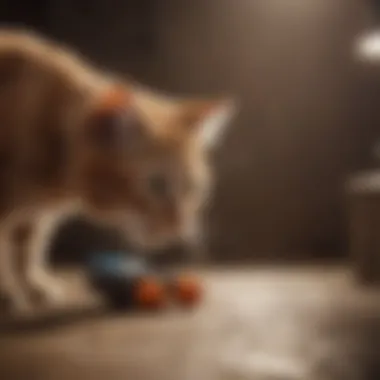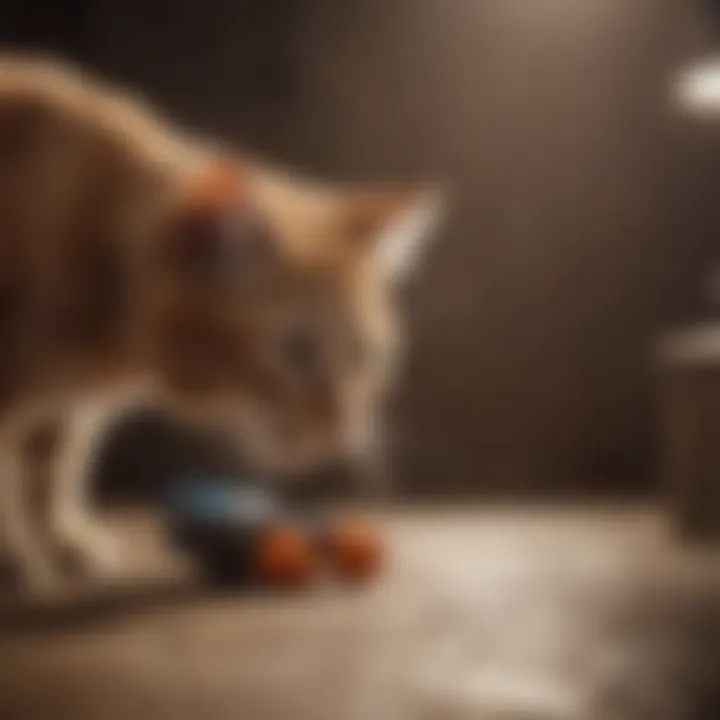Distinguishing Play from Aggression in Feline Behavior


Intro
Understanding the nature of feline interactions can sometimes feel like deciphering a secret code. With their agile movements and complex social structures, cats navigate a world rich in nuance. For those who share their homes with these creatures, recognizing the difference between playful antics and genuine aggression is vital to fostering a harmonious environment. The stakes are high; misinterpreting a cat’s body language could either lead to misplaced corrections or unnecessary anxiety for the feline.
This article aims to unpack these behaviors by examining elements such as body language, vocalizations, and the contexts in which these interactions occur. The nuances in these signals are essential for owners and enthusiasts alike, allowing for informed responses that could significantly enhance the human-animal bond.
Research Overview
In exploring the realm of feline behavior, different angles and methods have emerged that shed light on how we can best distinguish between play and aggression.
Methodological Approaches
Research on feline behavior has integrated various methodologies to gain insights into the delicate balance between playfulness and ferocity. Ethological studies, for instance, focus on observing cats in natural settings, enabling researchers to collect data on how individual and social factors drive their interactions. These observations can lead to deeper understanding of behaviors that might otherwise be misconstrued by human observers.
Experimental setups also play a role. By introducing specific stimuli, researchers can monitor cats’ reactions—testing hypotheses related to aggressive versus playful intent. This systematic examination reveals underlying physiological and psychological factors, enriching our understanding.
Significance and Implications
The implications of this research stretch far beyond academic interest. For cat owners, grasping the distinctions simplifies the task of managing behavior. Recognizing when a cat is engaging in play—a state often associated with enjoyment and social bonding—helps in creating a stimulating environment that respects their natural instincts.
Conversely, identifying aggression accurately allows for timely interventions, preventing potential injuries among animals or humans. With more awareness and knowledge from this research, caregivers can enrich the lives of their cats, ensuring emotional and physical well-being.
Current Trends in Science
As technology advances, so do the tools available for studying feline behavior. Researchers are employing innovative techniques that provide unprecedented insights into how cats communicate and interact.
Innovative Techniques and Tools
Using video analysis software, experts can now track minute movements and patterns that might go unnoticed by the naked eye. This technology enhances the granularity of observations, allowing for the identification of subtle cues that signify play or aggression. Additionally, advances in biometric measurements, such as heart rate and stress hormone analysis, help correlate behavioral observations with physiological responses.
Interdisciplinary Connections
Collaboration between fields such as psychology, ethology, and even technology has sparked fresh dialogues. Understanding feline behavior can benefit from insights in evolutionary biology and cognitive science, providing a more rounded view that encompasses behavioral motivations. The interdisciplinary nature of current research fosters comprehensive approaches, driving the conversation beyond traditional boundaries.
The awareness of a cat's body language and vocal cues can significantly impact the human-feline bond, paving the way for a safer, more enriching coexistence.
With these frameworks laid out, we can now delve deeper into recognizing the specific indicators of each behavior. By fostering an understanding of these distinctions, we embrace our role as compassionate caregivers, forever enhancing our relationships with our feline friends.
Understanding Feline Behavior
Understanding feline behavior is of paramount importance for anyone interacting with cats, whether as a pet owner, researcher, or enthusiast. Cats are often misunderstood creatures; their subtle body language and complex social interactions can leave even the most knowledgeable people scratching their heads. Thus, grasping the nuances of their behavior enables humans to respond appropriately, fostering a more harmonious relationship.
Understanding these behaviors allows caregivers to anticipate a cat's needs and emotional states. For instance, recognizing the difference between play and aggression can prevent misinterpretations that might lead to harm, both physically and psychologically. The benefits are multifold, including improved cat welfare, enhanced safety for both pet and owner, and stronger human-animal bonds.
With this understanding, caregivers can create optimal environments for their feline companions. By tuning in to how cats communicate through body language, vocalizations, and other signals, we can ensure that they feel secure and valued in their home. This article aims to provide an in-depth look into cat behaviors, particularly focusing on dissecting play versus aggression.
"Cats are the ultimate narcissists. You can tell this by all of the time they spend alone in the window, watching in silence to see who’s coming and going."
The Evolutionary Context of Cats
To comprehend feline behavior, it's essential to consider the evolutionary backdrop of cats. Throughout history, cats have carved their niche as solitary hunters, a trait that has significantly shaped their behaviors. Unlike pack animals, the ancestral lineage of domestic cats originates from species that thrived in isolation. This solitary approach to life introduced a suite of instinctual behaviors, specifically related to hunting, grooming, and social interactions.
Felines evolved as opportunistic predators, which influenced their playing patterns. Play, commonly seen as mere amusement by humans, serves a crucial preparatory role in honing their hunting skills. Young cats learn how to stalk, pounce, and ambush through playful interactions, reflecting instinctive behaviors that date back thousands of years. This evolutionary perspective marks the importance of play as not just entertainment but as a vital activity for skill acquisition.
Common Misconceptions About Cat Behavior
Several misconceptions about cat behavior can cloud judgment and lead to ineffective interactions between cats and humans. A common myth is that cats are no fun or are too aloof to engage with their owners. In truth, cats can be incredibly playful and social, but their ways of showing affection may be subtler than what might be expected from a dog, for instance. Additionally, many people believe that any aggressive behavior is simply a sign of a bad temperament. This isn't necessarily true; aggressive actions can often stem from fear, territorial disputes, or even overstimulation.
Another misconception is that playtime is unnecessary beyond a certain age. However, engaging adult cats in play is vital; it contributes to mental stimulation and prevents boredom that can lead to behavioral problems.
By dispelling these myths, we build a more comprehensive understanding of feline behavior. It's essenstial for caregivers to explore the origins behind what might seem like confusing actions and instead recognize them as part of a rich tapestry of instinctual traits.
In summary, understanding feline behavior is not a mere academic exercise; it is a practical necessity for the well-being of our cats and for fostering lasting relationships. The next sections of this article will delve deeper into both the characteristics of play and the signs of aggression, enhancing our perspective on these captivating animals.
Defining Play in Cats


Understanding the various elements of feline play is crucial for cat owners who seek to foster enriching environments for their companions. Play is more than just kitten antics; it serves significant functions that enrich a cat's life, develop social skills, and allow for natural instincts to shine. By defining what play looks like in cats, owners can better distinguish healthy interactions from potentially harmful aggressive behavior, leading to more harmonious coexistence.
Characteristics of Play Behavior
Feline play behavior is defined by a set of distinctive characteristics that can be easily observed:
- Exaggerated Movements: Cats usually exhibit a playful demeanor through an ample range of exaggerated, often clumsy movements. They may leap, spin, or pounce, showcasing their agility and instincts.
- Lack of Seriousness: Unlike aggressive encounters, playful behavior is marked by a lighthearted essence. If a cat’s tail is held high and their movements are loose rather than tense, they're likely engaged in play.
- Repetitiveness: Play often involves repeated actions—think of a cat batting around a ball of yarn or chasing a feather toy. These repetitive motions can be vital for honing their hunting skills without the high stakes of real predation.
- Pauses and Intermissions: Cats frequently take breaks during play, which is essential for maintaining balance. Unlike fights, where actions tend to escalate with little space for retreat, playful exchanges allow for pauses and resets, showcasing a willingness to engage in back-and-forth without aggression.
- Social Interaction: Play can involve other cats or even humans. A cat that playfully attempts to engage another feline or a human through gentle pounces or playful swats shows their willingness for bonding and interaction, indicating playful intent rather than hostility.
Understanding these characteristics can help pet owners see when their cats are merely having fun, which can lead to a deeper appreciation for their behavior and reinforce healthy interactions.
The Role of Play in Development
Play is not just idle amusement; it is crucial for a cat’s development in several ways:
- Skill Acquisition: For younger kittens, play allows for the acquisition of essential skills. Chasing, pouncing, and stalking during playtime mimic the hunting skills needed for survival in the wild.
- Social Skills: Through play, cats learn about social interactions. They understand boundaries and signals from other cats, figuring out when to hold back and when to push forward. This leads to healthier behaviors later in life.
- Stress Reduction: Engaging in playful activities can minimize stress and anxiety, providing an outlet for pent-up energy and frustration. A well-played cat is often a calmer cat, less likely to engage in aggressive antics.
- Confidence Building: Play can enhance a cat's confidence and overall well-being. When they successfully catch a toy or engage in silly antics, it boosts their self-esteem and can lead to a more outgoing and friendly demeanor.
Identifying Fighting Behavior
Understanding how to identify fighting behavior in cats is crucial for cat owners and enthusiasts alike. This distinction helps caregivers respond appropriately to their pets when tensions run high, ensuring a safe environment for all involved. Misinterpreting playful antics as aggression—or vice versa—can lead to increased stress for both the cat and its human companions. Thus, recognizing the signs and triggers of fighting behavior is paramount in maintaining harmony in a feline household.
Common Triggers for Aggression
Several factors can catalyze aggressive behavior in cats. Recognizing these triggers can help caregivers prevent confrontations before they escalate. Here are some common triggers associated with feline aggression:
- Territorial Disputes: Cats are territorial animals by nature. A new cat in the neighborhood, or even a stray entering their domain, can provoke a defensive response.
- Fear or Anxiety: Unfamiliar environments, loud noises, or sudden movements can make a cat feel threatened. When scared, a cat may choose to fight rather than flee, leading to aggression.
- Pain or Illness: A normally docile cat might become aggressive if it’s hurting or feeling unwell. Pain can make cats irritable, causing them to lash out unexpectedly.
- Overstimulation: While playing or being petted, a cat may reach a point of overstimulation, where it suddenly switches from playful to aggressive without much warning.
"Feline behavior is often a reflection of their instincts, and understanding those instinctual responses is key to ensuring a peaceful cohabitation."
Recognizing these triggers can prevent misunderstandings that could lead to physical confrontations.
Signs of Aggressive Behavior
Being able to identify the signs of aggression in cats allows owners to intervene in time and redirect their pet's energy. Cats exhibit a variety of behaviors that signal they are on the edge of aggression. Here are some indicators to watch for:
- Body Language: A cat may exhibit signs of aggression through its posture. A raised back, puffed-up fur, and an erect tail often indicate a tense situation. A cat may also crouch low to the ground, preparing to pounce or strike.
- Hissing and Growling: These vocalizations serve as warnings to potential threats. If a cat is showing its teeth or growling, it's time to back off and give it space.
- Swatting or Biting: Physical actions represent a clear indication of aggression. If a cat swats with its paws or bites during play, it may be expressing irritation or a desire to assert dominance.
- Ears Position: The position of a cat's ears can also signal aggressive tendencies. Ears that are flattened against the head suggest the cat is distressed and may strike if provoked further.
- Dilated Pupils: A cat’s pupils will often dilate when it is agitated, indicating a heightened state of arousal which can flip from playful to aggressive in a heartbeat.
By keeping an eye out for these signs, cat owners can effectively differentiate between play and fighting, allowing for timely intervention and a peaceful atmosphere at home.
Comparative Analysis of Play and Fighting
Understanding the differences between play and fighting in cats is crucial for owners who want to ensure their feline friends are happy and healthy. Not only can the analysis help identify fun, engaging behaviors from aggressive ones, but it can also foster deeper connections between cats and their human companions. Cats are notorious for exhibiting behaviors that can be misconstrued, especially since they are more silent observers than vocal communicators. Therefore, distinguishing between these two activities is fundamental to cat care and creates a safer environment for both cats and humans.
Physical Indicators
To truly understand if a cat is engaged in play or combat, one must look closely at their physical indicators. Cat body language provides a wealth of information—perhaps even more than their vocalizations. Here are key physical signs:
- Tail Position: A tail held high suggests a happy, playful cat, whereas a puffed or flicking tail indicates agitation or aggression.
- Ears: Forward-facing ears can signal engagement during play; tucked ears, conversely, are often a telltale sign of stress or hostility.
- Body Posture: Playful cats usually approach with relaxed bodies, while aggressive cats may crouch or stand tall, appearing more rigid.
- Paws and Claws: When cats are playing, they often use their paws but tend to keep their claws retracted. In a fight, claws are more likely to be extended, indicating a serious intent to harm.
Recognizing these indicators helps cat owners accurately interpret situations in real-time, promoting timely intervention if necessary.
Vocalizations and Sounds
Vocalizations can further clarify the intent behind a cat’s behavior. Understanding these sounds is akin to decoding a language uniquely crafted for the feline world. Here are some notable sounds:
- Chirps and Trills: Often associated with playful interactions. These sounds can be invitations for play, signaling a joyful mood.
- Growls and Hisses: Usually indicate discomfort, anger, or aggression. When a cat emits these sounds, it’s often a warning to back off.
- Purring: While generally associated with contentment, it can also signify a cat is trying to soothe itself during stressful encounters. Context is crucial here.
- Yowls: A series of yowls can indicate either excitement or distress. Pay attention to accompanying body language for clues.
"Understanding these vocal cues helps foster a bond between cats and their caretakers, preventing misunderstandings and ensuring a peaceful coexistence."
The examination of vocalizations and physical indicators undoubtedly enhances our perception of feline behavior. A well-informed cat owner will not only appreciate the playfulness in their pets but will also safeguard them from aggression, ensuring a harmonious household. Each cat has its own unique profile of behaviors, and deciphering them accurately can lead to a better understanding of their needs and emotions.
Contextual Factors in Feline Interactions
Understanding the nuances between play and aggression in feline companions cannot occur in a vacuum. Contextual factors play a vital role in shaping a cat's interaction style, influencing whether behavior leans toward playful antics or aggressive displays. These factors encompass environment, social structure, and individual personality traits. A deep dive into these elements reveals that there is much more than meets the eye when it comes to interpreting a kitty's actions.
Environment and Its Impact
The environment a cat inhabits serves as a backdrop for its behavior, greatly affecting how it interacts with fellow felines or humans. A chaotic or overstimulating environment may catalyze aggressive responses. For instance, a cluttered room with little space to escape may lead leads to tensions, pushing the cat towards displaying signs of aggression.


On the other hand, a calm, enriched environment often fosters playful behavior. When cats have appropriate toys, structures to climb, and safe zones, they feel secure enough to engage in play, like chasing a feather or wrestling with a toy. These activities are crucial for their physical and mental well-being.
For example, consider two cats in different scenarios: One is in a compact apartment with limited resources, while another has access to a spacious garden filled with stimulating sights and smells. The first cat might resort to aggression due to lack of stimulation, whereas the latter can freely express itself through playful behavior.
The Role of Social Structure
Felines are generally seen as solitary creatures, but they have their own social structures that influence their interactions. When assessing play versus aggression, understanding the dynamics of social hierarchy within a group is essential. In a multi-cat household, for instance, the established pecking order dictates how they relate to one another.
Higher-ranking cats may initiate playful interactions with lower-ranking companions, but if the latter feels threatened or cornered—often during play—the interaction can swiftly veer into aggression. This transition is not always easy to spot, as it tends to happen in a split second. Thus, the social structure acts as both a facilitator for play and a potential trigger for aggression.
In addition, it's also worth mentioning that not all cats have the same capacity for social interaction. Some may be more inclined to engage in playful behavior due to their personalities, while others may prefer solitude or can become easily overstimulated.
"Understanding your cat's personal tendencies and the context of its environment can mean the difference between a playful romp and an unexpected spat."
The Influence of Individual Personalities
Understanding the influence of individual personalities in cats is vital for comprehending both play and aggression. Just like humans, cats have unique character traits that shape their behavior. The curiosity of a rambunctious kitten differs significantly from the reserved demeanor of an older cat. Recognizing these individual differences helps cat owners respond appropriately to their pets’ actions, fostering a better environment for both play and social interactions.
Understanding Different Feline Temperaments
Feline temperaments can be broadly categorized into three main types: active and playful, calm and reserved, and aggressive or dominant. Each type brings distinct traits and behaviors.
- Active and Playful: These cats often engage in vigorous play, exhibiting high energy levels. Their willingness to pounce, bat at toys, or challenge their human companions indicates a healthy play drive. Understanding if a cat belongs to this category means knowing when they may need more physical activities to expend that energy.
- Calm and Reserved: Such cats might prefer lounging and observing rather than chasing after a toy. This temperament can sometimes be misinterpreted as disinterest in play or even aggression, especially if they retract or swat in self-defense when approached. Owners of these cats need to recognize and respect their need for more personal space.
- Aggressive or Dominant: This type tends to exhibit more territorial behavior, with assertive actions during both play and confrontations. They may perceive play as a challenge and react aggressively to other cats or even humans. Training and a clear understanding of their boundaries are crucial in managing their aggression.
Each cat’s personality influences how they engage in play or fight, underscoring the importance of evaluating individual temperaments.
Stress as a Factor in Behavior
Stress is another layer that complicates a cat's behavioral manifestation. A cat that feels threatened or anxious may behave aggressively, regardless of its underlying temperament. Stress can stem from various sources:
- Environmental Changes: Moving to a new home, changes in human dynamics, or the arrival of a new pet can unsettle a cat. They might feel their territory is compromised and react defensively.
- Health Issues: Sometimes a cat in pain can exhibit aggressive behavior as a means of self-protection. Regular veterinary check-ups can help identify underlying issues.
- Social Interactions: Cats that are not properly socialized with other animals may react aggressively out of fear or confusion when encountering new companions.
"A stressed cat is often not a true reflection of its personality; it’s simply trying to cope with its environment."
To keep behavior in check, owners can create a safe space filled with familiar objects and scents. Gradual introductions to changes and other pets can help alleviate stress.
Creating an enriched environment that caters to the innate needs of each cat allows them to feel secure. This may foster a sense of comfort during interactions that could otherwise turn aggressive but are rooted in the playful spirit.
By taking personalities and stress into account, caregivers can better manage their feline companions’ dynamic world, allowing for a healthy balance between play and aggression.
Behavioral Interventions and Training
Understanding how to effectively intervene in feline behavior is crucial for any cat owner. Behavioral interventions, especially those focused on training both playfulness and addressing aggression, are important tools that can bolster the bond between humans and their feline companions. Teaching your cat the ropes of social interactions not only nurtures their playful nature but also establishes a respectful environment that deters unwanted aggression.
From an early age, instilling the right habits can shape a cat’s behavior into one that is balanced and less prone to aggressive outbursts. Keep in mind that every cat is unique, and not all will respond to interventions in the same way. Owners should be patient and observant, tailoring their approaches based on the individual personalities and behaviors of their cats.
Encouraging Playful Interaction
Fostering playful interactions in cats can be both enjoyable and beneficial for their well-being. Play is an essential aspect of a feline's life, helping to develop their physical abilities and mental acuity. Here are a few strategies to encourage playful behavior:
- Interactive Toys: Introduce engaging toys that mimic prey movement. Toys like feather wands or laser pointers can stimulate a cat's hunting instincts and promote healthy play.
- Scheduled Playtime: Establish a routine that incorporates daily play sessions. Cats thrive on predictability, so a dedicated time for play can help them understand when to expect interactive activities.
- Safe Spaces for Exploration: Create an environment that encourages exploration. Cats love to be curious, and providing them with climbing structures and hiding spots can catalyze playfulness.
- Positive Reinforcement: Reward playful behavior with treats or praise. This sort of reinforcement can help shape future interactions, teaching the cat that being active and engaged during playtime is beneficial.
Remember, when engaging a cat in play, be attentive to their body language. If they start to display signs of frustration or aggression—like swatting or hissing—it's crucial to wind down playtime and recalibrate the approach.
Addressing Aggressive Behavior
Recognizing and addressing aggressive behavior in cats is essential for a harmonious household. Such behavior can stem from fear, territorial disputes, or overstimulation. Here are some effective methods for managing aggression:
- Identifying Triggers: Observing and understanding what provokes aggression in your cat is the first step. Keep a diary of aggressive episodes, noting environmental factors or interactions that precede these behaviors.
- Creating a Calm Environment: Stress can exacerbate aggression, thus creating a peaceful and safe space for your cat is vital. Use soft music, calming scents like lavender, or ensure there are dark, quiet places for your cat to retreat to.
- Redirecting Energy: Sometimes, aggression is just pent-up energy seeking an outlet. Offer interactive toys or engage in play with a wand toy to redirect the energy from aggression toward fun activities.
- Consulting a Professional: If aggressive behavior persists, it might be wise to consult a veterinarian or animal behaviorist. They can provide tailored advice and support based on your cat’s specific needs.
It’s critical to address aggressive behavior promptly; allowing it to continue can lead to entrenched patterns that are much harder to correct later on.
In the end, behavior interventions address both positive play and negative aggression, ensuring that a cat’s life is rich, stimulating, and less fraught with conflict. Using a thoughtful approach to training and intervention enhances quality of life for both feline friends and their human caretakers.
The Role of Play in Cat Welfare
Play is not just a leisure activity for cats; it plays a fundamental role in their overall welfare. Engaging in play is crucial for their psychological and physical well-being. While many cat owners may think of play as mere entertainment, it serves several vital functions that contribute to a cat's health and happiness.
First and foremost, play acts as a natural outlet for energy. Cats, especially young ones, possess a significant amount of energy that needs to be expended. If this energy isn’t channelled constructively, it can lead to behavioral issues such as aggression or anxiety. For instance, a cat that has no playtime may start pouncing on unsuspecting family members or engaging in disruptive behaviors. By providing regular opportunities for play, owners can help prevent such negative outcomes.


Additionally, play is essential for physical fitness. Just like humans, cats need exercise to keep their bodies healthy. Through activities like chasing feather toys or batting around a ball, cats engage muscles and maintain their agility. This is particularly crucial for indoor cats, who may not have access to the same range of movement offered by an outdoor environment. A fit cat is more likely to enjoy a longer, healthier life, free from issues like obesity and joint problems.
Moreover, play promotes mental stimulation. Cats are intelligent creatures that thrive on challenges. Engaging them in activities that require problem-solving—such as puzzle feeders—can keep their minds sharp. This is integral not only to their mental health but also helps combat boredom, which can be just as detrimental as a lack of physical exercise.
"Play is the highest form of research." - Albert Einstein
This sentiment rings true for our feline friends as well. Through play, they practice hunting skills, which are crucial for their survival instincts. Even domesticated cats, who may never hunt for food, retain those instincts. When they stalk and pounce on toys, they are reinforcing their natural behaviors.
Enhancing Mental Stimulation
Mental stimulation is a key component of a cat's emotional health. Interactive play helps in various ways:
- Encouraging Problem-Solving: Toys that move unpredictably or require cats to think to get a treat stimulate their cognitive abilities.
- Social Interaction: Engaging with their owners during playtime fosters a sense of connection and security, which reduces stress.
- Variety: Rotating toys keeps the environment fresh and encourages cats to engage with something new, preventing the familiarity that can lead to boredom.
The Importance of Enrichment Activities
Enrichment activities are not limited to traditional play with toys. They encompass a broader range of practices aimed at improving feline welfare. Consider the following:
- Environmental Enrichment: Adding climbing shelves or scratching posts allows cats to express natural behaviors like climbing and scratching, which promotes health and reduces stress.
- Scent-Based Enrichment: Cats have a keen sense of smell. Using catnip or introducing different scents can stimulate their olfactory senses and promote curiosity.
- Social Enrichment: Facilitating safe interactions with other cats or pets can enhance social skills.
Monitoring and Understanding Feline Behavior
Understanding how to monitor feline behavior is key for any cat owner seeking to deepen their bond with their pet. The way cats express themselves, be it through play or aggression, can reveal much about their needs, moods, and motivations. Observing these behaviors not only enhances our comprehension but also guides us in providing a more nurturing environment for our feline companions.
Observational skills elevate cat care. By honing in on the subtleties of a cat's behavior, owners can catch the crucial differences between play and aggression. Each scenario presents unique signals. Recognizing these can prevent misunderstandings that might result in stress for either party. For instance, some aggressive actions like hissing or an arched back are evident; however, other behaviors such as tail flicks or soft pawing can be more nuanced and require careful attention.
There are several benefits to closely monitoring a cat's behavior:
- Early Identification of Stress: Cats may not always vocalize their displeasure or discomfort, making it essential to identify behavioral changes as indicators of stress or illness.
- Enhancing Social Interactions: Understanding how feline interactions work supports better management of social encounters, whether among cats or with humans.
- Tailored Activities: Once an owner understands distinct play behaviors, they can engage their cats more effectively, aligning activities with their individual personalities.
Considerations about monitoring behavior include the context in which these behaviors occur. Cats react not only to each other but also to environmental factors. Changes in their surroundings—like new pets or loud noises—can trigger different responses. Observing how a cat behaves when faced with various stimuli can illuminate its temperament and coping strategies.
To summarize, monitoring feline behavior is more than an academic exercise; it is a fundamental practice that fosters a deeper connection between cats and their owners. It builds a foundation of trust and allows for more tailored approaches to meet feline needs. The understanding gained through observance equips owners with the tools necessary to interpret their pet's intentions correctly.
Observational Techniques for Owners
Owners can utilize a variety of observational techniques to deepen their understanding of their cats. Firstly, it is important to note the environment where the cat spends most of its time. Is it calm, or does it feature stimuli that may cause distraction or stress?
- Creating a Baseline Observation: Before any changes occur, owners should document typical behaviors. This may include noting when the cat enjoys play most or which toys it prefers. Recording these details allows for more precise understanding later on.
- Watching for Body Language: Body posture provides insight into a cat’s emotional state. For example, a relaxed cat will often have a straight tail held high as compared to a frightened one, where the tail might be tucked.
- Keeping Notes: Keeping a journal can help track patterns over time and identify triggers that lead to aggressive responses or playful behavior.
- Using Video: Sometimes seeing actions on video can offer clearer insights. Owners may not notice subtle behaviors in real-time, but reviewing footage can highlight important cues.
Incorporating these techniques enhances both the owner's capability to observe and the cat's well-being.
When to Seek Professional Help
Despite the best efforts of owners, there are instances when the situation warrants professional intervention. Here are several indicators that it might be time to consult a veterinarian or a feline behaviorist:
- Chronic Aggression: If a cat consistently displays aggressive behavior—particularly if it inflicts injury or fear on its companions—this can be a serious concern that might need specialized attention.
- Behavioral Changes: Any sudden changes in behavior can indicate underlying health issues. For instance, unexpected aggression can mask pain or fear.
- Incompatibility Issues: If household cats can’t seem to get along despite owner efforts to encourage interaction, a professional can provide tailored advice based on their observations.
- Code Red Situations: Emerging behaviors such as excessive vocalizations, litter box issues, or destructiveness might signal that a cat is overwhelmed and needs immediate help.
Reaching out to professionals can provide not just answers but strategies on how to redirect unwanted behaviors and foster a healthier dynamic in the household.
Understanding feline behavior through careful monitoring is a pivotal part of responsible cat ownership. It's a blend of observation, intuition, and seeking help when needed, all aimed at providing the best possible environment for our feline friends.
Concluding Thoughts on Cat Behavior
Understanding the complexity of feline behavior is essential for both cat caregivers and the broader community interested in animal welfare. This article has examined the distinct lines that separate play from aggression in our feline friends. Each section has drawn attention to behavioral cues, physiological traits, and environmental influences that shape interactions among cats.
Final Insights for Cat Caregivers
As caregivers, it is our responsibility to interpret feline actions accurately. Misreading aggression as play can lead to stress and injury, not only for the cats but for humans involved too. Some key takeaways include:
- Observational Skills: Developing a keen eye for your cat’s body language can greatly enhance understanding. Note how their tail position or ear orientation changes during interactions.
- Response Strategies: Knowing when to step in and redirect play or aggression can prevent misunderstandings. For instance, if you notice one cat holding another’s i.e.mouth swiftly or showing signs like flattened ears, it’s time to intervene carefully.
- Promoting Positive Play: Creating an environment enriched with toys and interactive experiences encourages healthy play and socialization. It’s worth adding scratching posts, tunnels, and varied toys to keep their minds engaged.
By actively participating in their environment, caregivers not only ensure their safety but also solidify their bond with their pets.
Continuing Research on Feline Behavior
The field of feline behavior is continuously evolving. New studies and insights are unlocking layers of understanding about how cats communicate and interact with one another and their human companions. While this article has provided foundational knowledge, further exploration is necessary.
Some pertinent areas for future research include:
- The Impact of Early Socialization: Investigating how early interactions with siblings and humans shape aggressive and playful behavior later in life.
- Understanding Vocalizations: How different sounds contribute to feline interactions could prove significant. There are variations in meows, growls, and purrs that might be unique to individual cats.
- Environmental Influences: Studies focusing on how environment alters behavior offer insights into creating better living conditions for indoor cats, factoring in aspects like space, interaction levels, and stimuli available.
By delving deeper into these areas, we can gain a more comprehensive perspective on feline behavior, enhancing both educational and practical approaches to cat care.
The more we learn about feline behavior, the better we can serve the needs of our feline companions, elevating wellbeing and creating harmonious living environments.



